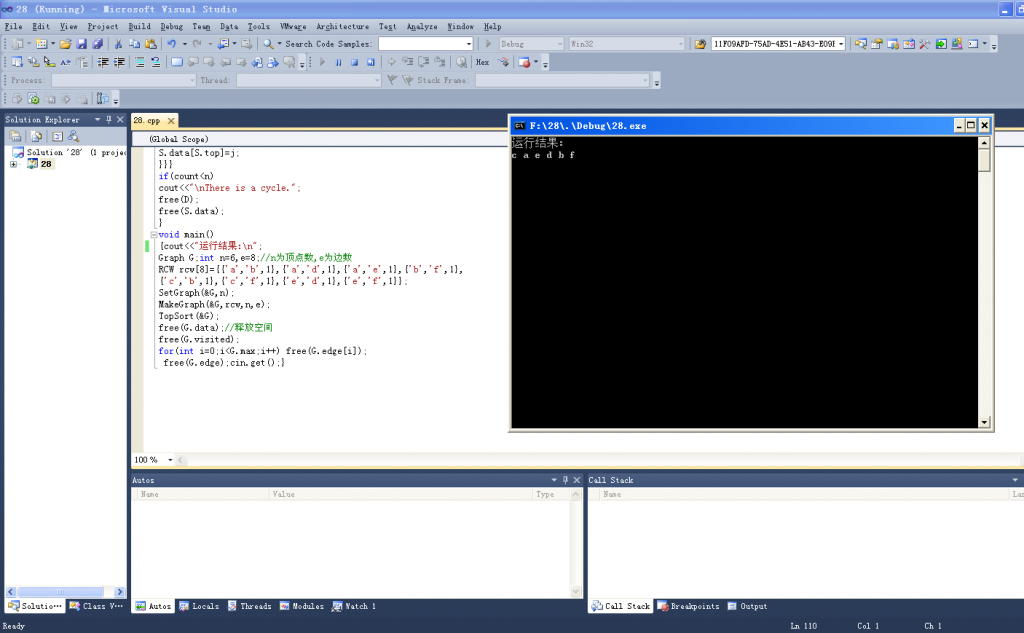什么是拓扑序列
通常,这样的线性序列称为满足拓扑次序(Topological Order)的序列,简称拓扑序列。简单的说,由某个集合上的一个偏序得到该集合上的一个全序,这个操作称之为拓扑排序。离散数学中关于偏序和全序的定义:
若集合X上的关系是R是自反的、反对称的和传递的,则称R是集合X上的偏序关系。
设R是集合X上的偏序(Partial Order),如果对每个x,y属于X必有xRy 或 yRx,则称R是集合X上的全序关系。
注意:
①若将图中顶点按拓扑次序排成一行,则图中所有的有向边均是从左指向右的。
②若图中存在有向环,则不可能使顶点满足拓扑次序。
③一个DAG的拓扑序列通常表示某种方案切实可行。
一般应用
拓扑排序常用来确定一个依赖关系集中,事物发生的顺序。例如,在日常工作中,可能会将项目拆分成A、B、C、D四个子部分来完成,但A依赖于B和D,C依赖于D。为了计算这个项目进行的顺序,可对这个关系集进行拓扑排序,得出一个线性的序列,则排在前面的任务就是需要先完成的任务。
实现的基本方法
拓扑排序方法如下:
(1)从有向图中选择一个没有前驱(即入度为0)的顶点并且输出它.
(2)从网中删去该顶点,并且删去从该顶点发出的全部有向边.
(3)重复上述两步,直到剩余的网中不再存在没有前趋的顶点为止.
打开IDE

我们创建一个工程

定义声明如下
#include "stdafx.h"
//拓扑排序
#include<iostream>
#include<iomanip>
#include<stdlib.h>
using namespace std;
typedef struct
{char w1,w2;
float w;
}RCW;
typedef struct
{char *data;
int *visited;
float **edge;
int max,size;
}Graph;
//初始化图
void SetGraph(Graph *G,int n)
{int i,j;
G->data=new char[n];
G->visited=new int[n];
G->edge=(float **)malloc(n*sizeof(float *));
for(i=0;i<n;i++)
G->edge[i]=(float *)malloc(n*sizeof(float));
for(i=0;i<n;i++) G->visited[i]=0;
for(i=0;i<n;i++)
for(j=0;j<n;j++) G->edge[i][j]=0;
G->max=n;
G->size=0;
}
//构造图
void MakeGraph(Graph *G,RCW r[],int n,int e)
{int m=0;
while(m<n)
{if(G->size==G->max)
{cout<<"Graph is full!\n";
exit(1);}
G->data[G->size]='a'+m;
G->size++;m++;}
//插入弧
for(int p=0;p<e;p++)
{int i,j,k;
for(k=0;k<n;k++)
{if(r[p].w1==G->data[k]) i=k;
if(r[p].w2==G->data[k]) j=k;}
G->edge[i][j]=r[p].w;}
}
typedef struct
{int *data;
int max,top;
}Stack;
void TopSort(Graph *G)
{int i,j,n,d,count=0,*D;
Stack S;
if(G->size==0) return;
n=G->size;
S.data=new int[n];
S.max=n;S.top=-1;
D=new int[n];
for(j=0;j<n;j++)
{d=0;
for(i=0;i<n;i++)
if(G->edge[i][j]!=0) d++;
D[j]=d;
if(d==0)
{if(S.top==S.max-1)
{cout<<"Stack is full!\n";exit(1);}
S.top++;
S.data[S.top]=j;
}
}
while(!(S.top==-1))
{if(S.top==-1)
{cout<<"Pop an empty stack!\n";exit(1);}
S.top--;
i=S.data[S.top+1];
cout<<G->data[i]<<' ';
count++;
for(j=0;j<n;j++)
if(G->edge[i][j]!=0)
{D[j]--;
if(D[j]==0)
{if(S.top==S.max-1)
{cout<<"Stack is full!\n";exit(1);}
S.top++;
S.data[S.top]=j;
}}}
if(count<n)
cout<<"\nThere is a cycle.";
free(D);
free(S.data);
}调用如下
void main()
{cout<<"运行结果:\n";
Graph G;int n=6,e=8;//n为顶点数,e为边数
RCW rcw[8]={{'a','b',1},{'a','d',1},{'a','e',1},{'b','f',1},
{'c','b',1},{'c','f',1},{'e','d',1},{'e','f',1}};
SetGraph(&G,n);
MakeGraph(&G,rcw,n,e);
TopSort(&G);
free(G.data);//释放空间
free(G.visited);
for(int i=0;i<G.max;i++) free(G.edge[i]);
free(G.edge);
cin.get();
}
效果如下

代码下载如下